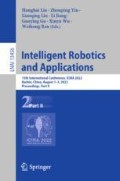Abstract
The inverse kinematics (IK) of continuum robot (CR) is an important factor to guarantee motion accuracy. How to construct a concise IK model is very essential for the real-time control of CR. A new geometric algorithm for solving the IK of CR is proposed in this paper. Based on Piecewise Constant Curvature (PCC) model, the kinematics model of CR is constructed and the envelope surface of the single segment is calculated. The IK of CR is obtained by solving the intersection of surfaces. The spatial problem is transformed into a plane using a set of parallel planes, and the intersection is solved using the k-means clustering algorithm. The algorithm's real-time performance and applicability are improved further by increasing the sampling rate and decreasing the range of included angles. A distinct sequence is designed for solving the IK of CR. The efficiency and effectiveness of geometric are validated in comparison to some of the most popular IK algorithms. Finally, the accuracy of the algorithm is further validated by a physical prototype experiment.
Access this chapter
Tax calculation will be finalised at checkout
Purchases are for personal use only
References
Pritts, M.B., Rahn, C.D.: Design of an artificial muscle continuum robot. In: IEEE International Conference on Robotics and Automation, 2004. Proceedings. ICRA’04, pp. 4742–4746 (2004)
Chikhaoui, M.T., Burgner-Kahrs, J.: Control of continuum robots for medical applications: state of the art. In: ACTUATOR 2018; 16th International Conference on New Actuators, pp. 1–11. VDE (2018)
Buckingham, R., Graham, A.: Nuclear snake-arm robots. Ind. Robot: an Int. J. 39, 6–11 (2012)
Burgner-Kahrs, J., Rucker, D.C., Choset, H.: Continuum robots for medical applications: a survey. IEEE Trans. Rob. 31(6), 1261–1280 (2015)
Xu, K., Simaan, N.: An investigation of the intrinsic force sensing capabilities of continuum robots. IEEE Trans. Robot. 24(3), 576–587
Buckingham, R., et al.: Snake-arm robots: a new approach to aircraft assembly (No. 2007-01-3870). SAE Technical Paper (2007)
Dulęba, I., Opałka, M.: A comparison of Jacobian-based methods of inverse kinematics for serial robot manipulators. Int. J. Appl. Math. Comput. Sci. 23(2), 373–382 (2013)
Rucker, D.C., Webster, R.J.: Computing jacobians and compliance matrices for externally loaded continuum robots. In: 2011 IEEE International Conference on Robotics and Automation, pp. 945–950. IEEE (2011)
Cobos-Guzman, S., Palmer, D., Axinte, D.: Kinematic model to control the end-effector of a continuum robot for multi-axis processing. Robotica 35(1), 224–240 (2017)
Machado, J.T., Lopes, A.M.: A fractional perspective on the trajectory control of redundant and hyper-redundant robot manipulators. Appl. Math. Model. 46, 716–726 (2017)
Jiang, H., et al.: A two-level approach for solving the inverse kinematics of an extensible soft arm considering viscoelastic behavior. In: 2017 IEEE International Conference on Robotics and Automation (ICRA), pp. 6127-6133 (2017)
Melingui, A.: Neural networks-based approach for inverse kinematic modeling of a compact bionic handling assistant trunk. In: 2014 IEEE 23rd International Symposium on Industrial Electronics (ISIE), pp. 1239–1244 (2014)
Thuruthel, T.G., Shih, B., Laschi, C., Tolley, M.T.: Soft robot perception using embedded soft sensors and recurrent neural networks. Sci Robot. 4(26), eaav1488 (2019)
George Thuruthel, T., Ansari, Y., Falotico, E., Laschi, C.: Control strategies for soft robotic manipulators: a survey. Soft Rob. 5(2), 149–163 (2018)
Yahya, S., Moghavvemi, M., Mohamed, H.A.: Geometrical approach of planar hyper-redundant manipulators: inverse kinematics, path planning and workspace. Simul. Model. Pract. Theory 19(1), 406–422 (2011)
William II, R.L., Mayhew IV, J.B.: Obstacle-free control of the hyper-redundant nasa inspection manipulator. In: Proc. of the Fifth National Conf. on Applied Mechanics and Robotics, pp. 12–15 (1997)
Cho, C.N., Jung, H., Son, J., Sohn, D.K., Kim, K.G.: An intuitive control algorithm for a snake-like natural orifice transluminal endoscopic surgery platform: a preliminary simulation study. Biomed. Eng. Lett. 6(1), 39–46 (2016)
Xiong, Z., Tao, J., Liu, C.: Inverse kinematics of hyper-redundant snake-arm robots with improved tip following movement. Robot 40, 37–45 (2018)
Sreenivasan, S., Goel, P., Ghosal, A.: A real-time algorithm for simulation of flexible objects and hyper-redundant manipulators. Mech. Mach. Theory 45(3), 454–466 (2010)
Gong, Z., et al.: A soft manipulator for efficient delicate grasping in shallow water: Modeling, control, and real-world experiments. The Int. J. Robot. Res. 40(1), 449–469 (2021)
Jones, B.A., Walker, I.D.: Kinematics for multisection continuum robots. IEEE Trans. Rob. 22(1), 43–55 (2006)
Webster, R.J., III., Jones, B.A.: Design and kinematic modeling of constant curvature continuum robots: a review. The Int. J. Robot. Res. 29(13), 1661–1683 (2010)
Funding
This work was supported in part by the National Natural Science Foundation of China (Grant No. U1813221) and the National Key R&D Program of China (Grant No. 2019YFB1311200).
Author information
Authors and Affiliations
Corresponding author
Editor information
Editors and Affiliations
Appendix
Rights and permissions
Copyright information
© 2022 The Author(s), under exclusive license to Springer Nature Switzerland AG
About this paper
Cite this paper
Wu, H., Yu, J., Pan, J., Ge, G., Pei, X. (2022). A New Geometric Method for Solving the Inverse Kinematics of Two-Segment Continuum Robot. In: Liu, H., et al. Intelligent Robotics and Applications. ICIRA 2022. Lecture Notes in Computer Science(), vol 13456. Springer, Cham. https://doi.org/10.1007/978-3-031-13822-5_10
Download citation
DOI: https://doi.org/10.1007/978-3-031-13822-5_10
Published:
Publisher Name: Springer, Cham
Print ISBN: 978-3-031-13821-8
Online ISBN: 978-3-031-13822-5
eBook Packages: Computer ScienceComputer Science (R0)

